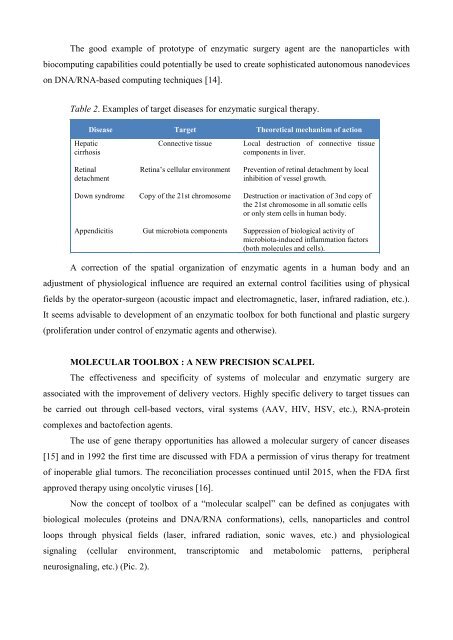Foundations for Molecular and Enzymatic Functional Surgery
This paper presents an approach of molecular and enzymatic surgery for treatment of human diseases, including opportunity for use of systemic biology methods in planning of surgical interventions, possible biological components of a “molecular scalpel”, and problems of standardization, medical ethics and clinical trials of the new pharma-surgical toolbox. In conclusions is proposed to consider of molecular and enzymatic surgery methods as realization of the principles of “functional surgery” and also further development of fast track surgery with attaining the modern concept of a personalized approach to surgical treatment of the patient.
This paper presents an approach of molecular and enzymatic surgery for treatment of human diseases, including opportunity for use of systemic biology methods in planning of surgical interventions, possible biological components of a “molecular scalpel”, and problems of standardization, medical ethics and clinical trials of the new pharma-surgical toolbox. In conclusions is proposed to consider of molecular and enzymatic surgery methods as realization of the principles of “functional surgery” and also further development of fast track surgery with attaining the modern concept of a personalized approach to surgical treatment of the patient.
Create successful ePaper yourself
Turn your PDF publications into a flip-book with our unique Google optimized e-Paper software.
The good example of prototype of enzymatic surgery agent are the nanoparticles with<br />
biocomputing capabilities could potentially be used to create sophisticated autonomous nanodevices<br />
on DNA/RNA-based computing techniques [14].<br />
Table 2. Examples of target diseases <strong>for</strong> enzymatic surgical therapy.<br />
Hepatic<br />
cirrhosis<br />
Disease Target Theoretical mechanism of action<br />
Connective tissue<br />
Local destruction of connective tissue<br />
components in liver.<br />
Retinal<br />
detachment<br />
Retina’s cellular environment<br />
Prevention of retinal detachment by local<br />
inhibition of vessel growth.<br />
Down syndrome Copy of the 21st chromosome Destruction or inactivation of 3nd copy of<br />
the 21st chromosome in all somatic cells<br />
or only stem cells in human body.<br />
Appendicitis Gut microbiota components Suppression of biological activity of<br />
microbiota-induced inflammation factors<br />
(both molecules <strong>and</strong> cells).<br />
A correction of the spatial organization of enzymatic agents in a human body <strong>and</strong> an<br />
adjustment of physiological influence are required an external control facilities using of physical<br />
fields by the operator-surgeon (acoustic impact <strong>and</strong> electromagnetic, laser, infrared radiation, etc.).<br />
It seems advisable to development of an enzymatic toolbox <strong>for</strong> both functional <strong>and</strong> plastic surgery<br />
(proliferation under control of enzymatic agents <strong>and</strong> otherwise).<br />
MOLECULAR TOOLBOX : A NEW PRECISION SCALPEL<br />
The effectiveness <strong>and</strong> specificity of systems of molecular <strong>and</strong> enzymatic surgery are<br />
associated with the improvement of delivery vectors. Highly specific delivery to target tissues can<br />
be carried out through cell-based vectors, viral systems (AAV, HIV, HSV, etc.), RNA-protein<br />
complexes <strong>and</strong> bactofection agents.<br />
The use of gene therapy opportunities has allowed a molecular surgery of cancer diseases<br />
[15] <strong>and</strong> in 1992 the first time are discussed with FDA a permission of virus therapy <strong>for</strong> treatment<br />
of inoperable glial tumors. The reconciliation processes continued until 2015, when the FDA first<br />
approved therapy using oncolytic viruses [16].<br />
Now the concept of toolbox of a “molecular scalpel” can be defined as conjugates with<br />
biological molecules (proteins <strong>and</strong> DNA/RNA con<strong>for</strong>mations), cells, nanoparticles <strong>and</strong> control<br />
loops through physical fields (laser, infrared radiation, sonic waves, etc.) <strong>and</strong> physiological<br />
signaling (cellular environment, transcriptomic <strong>and</strong> metabolomic patterns, peripheral<br />
neurosignaling, etc.) (Pic. 2).












